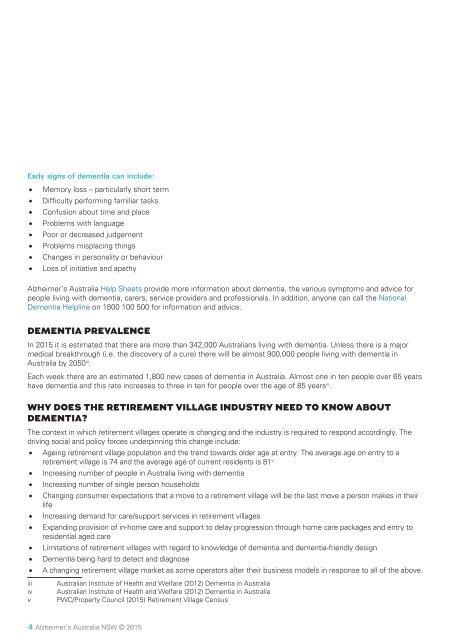DEMENTIA GUIDE FOR THE AUSTRALIAN RETIREMENT VILLAGE INDUSTRY
AANSW_Dementia_Guide_for_the-Australian_Retirement_Village_Industry
AANSW_Dementia_Guide_for_the-Australian_Retirement_Village_Industry
Create successful ePaper yourself
Turn your PDF publications into a flip-book with our unique Google optimized e-Paper software.
Early signs of dementia can include:<br />
• Memory loss – particularly short term<br />
• Difficulty performing familiar tasks<br />
• Confusion about time and place<br />
• Problems with language<br />
• Poor or decreased judgement<br />
• Problems misplacing things<br />
• Changes in personality or behaviour<br />
• Loss of initiative and apathy<br />
Alzheimer’s Australia Help Sheets provide more information about dementia, the various symptoms and advice for<br />
people living with dementia, carers, service providers and professionals. In addition, anyone can call the National<br />
Dementia Helpline on 1800 100 500 for information and advice.<br />
<strong>DEMENTIA</strong> PREVALENCE<br />
In 2015 it is estimated that there are more than 342,000 Australians living with dementia. Unless there is a major<br />
medical breakthrough (i.e. the discovery of a cure) there will be almost 900,000 people living with dementia in<br />
Australia by 2050 iii .<br />
Each week there are an estimated 1,800 new cases of dementia in Australia. Almost one in ten people over 65 years<br />
have dementia and this rate increases to three in ten for people over the age of 85 years iv .<br />
WHY DOES <strong>THE</strong> <strong>RETIREMENT</strong> <strong>VILLAGE</strong> <strong>INDUSTRY</strong> NEED TO KNOW ABOUT<br />
<strong>DEMENTIA</strong>?<br />
The context in which retirement villages operate is changing and the industry is required to respond accordingly. The<br />
driving social and policy forces underpinning this change include:<br />
• Ageing retirement village population and the trend towards older age at entry. The average age on entry to a<br />
retirement village is 74 and the average age of current residents is 81 v<br />
• Increasing number of people in Australia living with dementia<br />
• Increasing number of single person households<br />
• Changing consumer expectations that a move to a retirement village will be the last move a person makes in their<br />
life<br />
• Increasing demand for care/support services in retirement villages<br />
• Expanding provision of in-home care and support to delay progression through home care packages and entry to<br />
residential aged care<br />
• Limitations of retirement villages with regard to knowledge of dementia and dementia-friendly design<br />
• Dementia being hard to detect and diagnose<br />
• A changing retirement village market as some operators alter their business models in response to all of the above.<br />
iii<br />
iv<br />
v<br />
Australian Institute of Health and Welfare (2012) Dementia in Australia<br />
Australian Institute of Health and Welfare (2012) Dementia in Australia<br />
PWC/Property Council (2015) Retirement Village Census<br />
4 Alzheimer’s Australia NSW © 2015


